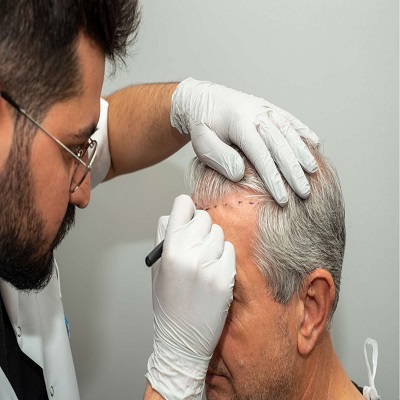Hair transplants have evolved from a niche cosmetic procedure to a mainstream solution for hair loss, thanks to advancements in medical science and surgical precision. But why are Islamabad’s hair transplant clinics emerging as leaders in this field—not just in Pakistan, but across the region?
In this blog, we’ll explore the scientific foundation of hair transplants, how they work, and why Islamabad's clinics are setting new standards in safety, technology, and results.
The Biology of Hair Loss
To understand hair transplantation, we first need to understand why hair loss happens. The most common cause is androgenetic alopecia (male or female pattern baldness), which is:
- Genetic
- Progressive
- Hormone-driven (primarily by DHT – dihydrotestosterone)
Hair follicles in the crown and frontal areas are sensitive to DHT, leading to gradual miniaturization and eventual baldness. However, follicles in the back and sides of the scalp are genetically resistant to DHT—this is called the donor zone.
Transplant science works by relocating these resistant follicles to bald areas, where they continue to grow naturally.
How Hair Transplants Work: A Scientific Overview
Hair transplant procedures are based on the principle of “donor dominance”—the idea that transplanted follicles retain their characteristics even after relocation.
There are two primary scientific methods used:
1. FUE (Follicular Unit Extraction)
- Individual follicular units are extracted using micro-punch tools
- No stitches required, minimal scarring
- Ideal for smaller areas or patients who prefer short hair
2. FUT (Follicular Unit Transplantation)
- A strip of scalp is surgically removed from the donor zone
- Grafts are microscopically dissected
- Higher graft yield, but a linear scar may remain
Both methods require precision, experience, and anatomical knowledge to preserve graft viability and ensure natural growth patterns.
The Science of Graft Survival
A successful transplant isn’t just about moving hair—it’s about ensuring that each graft survives, anchors, and grows. Islamabad’s top clinics follow scientific protocols to improve success rates:
- Cooling & hydration solutions for graft preservation (e.g., saline or HypoThermosol)
- Minimal out-of-body time to keep follicles alive
- Use of stereomicroscopes for precise graft dissection
- Implantation angle and density control for natural aesthetics
These steps require training and a well-coordinated surgical team, which is where Islamabad’s clinics excel.
Why Islamabad Clinics Stand Out Scientifically
Islamabad may not be the first name that comes to mind when thinking of cutting-edge medical care—but that perception is changing fast. Here’s why:
1. Skilled, Science-Literate Surgeons
Many leading hair transplant surgeons in Islamabad are:
- Board-certified dermatologists or plastic surgeons
- Trained internationally (UK, USA, Turkey)
- Regular participants in medical conferences and workshops
They stay updated with evolving research in:
- Stem cell therapy
- Platelet-Rich Plasma (PRP)
- Scalp micro-pigmentation
- Robotic-assisted FUE (coming soon to select clinics)
2. Advanced Diagnostic Tools
Islamabad clinics are increasingly equipped with:
- Trichoscopy (scalp imaging) to measure follicular health
- Digital hair density analysis tools
- 3D hairline simulation software
These tools allow for customized treatment plans backed by measurable data—not guesswork.
3. Focus on Graft Viability
Top clinics understand that 90% of transplant success lies in graft handling. You’ll find:
- Temperature-controlled graft storage units
- Dedicated technicians for graft separation and hydration
- Strict aseptic protocols to avoid infection
Science-based graft management leads to higher survival rates (90–95%) and long-lasting results.
4. Post-Op Recovery Backed by Research
Islamabad clinics provide:
- Evidence-backed post-op care instructions
- PRP therapy (platelet-rich plasma) to accelerate healing
- FDA-approved medications (Finasteride, Minoxidil) for supporting existing hair
Some also offer nutritional counseling and low-level laser therapy (LLLT)—both scientifically validated to enhance hair health.
Clinical Results & Patient Outcomes
The real proof lies in the results. Clinics like SKN Cosmetics, Cosmesurge International, and IHTC have documented thousands of successful cases—with outcomes that match international benchmarks.
Key metrics include:
- High graft survival rate (90%+)
- Minimal downtime (3–5 days)
- Natural hairline design based on facial symmetry and ethnic features
- Long-term density retention
These clinics also maintain before-and-after galleries, and many offer video testimonials to showcase real transformations.
Comparing Islamabad with Other Hair Transplant Destinations
Let’s compare Islamabad’s science-driven approach with some popular alternatives:
LocationScientific StandardsCostQualityIslamabadHigh, growing rapidlyLow to mid-rangeExcellentTurkeyVery high, internationally recognizedMid to highTop-tierIndiaVaries widelyLowInconsistentUAEHighHighExcellent but expensive
Islamabad offers a balance of affordability, science, and personalized care—ideal for both locals and medical tourists.
Should You Trust the Science?
Absolutely—but only if the clinic you choose is transparent, credentialed, and research-focused. Here’s how to spot one:
- They conduct scalp analysis and planning before quoting grafts
- The surgeon is present during the procedure—not just technicians
- They share clear graft survival expectations and risks
- They follow WHO sterilization standards and explain the procedure scientifically
Clinics in Islamabad Leading the Way
Here are three science-focused clinics worth considering:
SKN Cosmetics Clinic
- Offers FUE, FUT, PRP
- Surgeon-led procedures
- Focus on natural hairline design
Cosmesurge International Hospital
- Multidisciplinary team
- PRP and advanced trichology services
- International training and certifications
Islamabad Hair Transplant Clinic (IHTC)
- Transparent pricing
- Detailed pre-op diagnostics
- High patient satisfaction rate
Final Thoughts: Trust the Science, Choose the Right Clinic
Hair transplants are no longer just cosmetic—they’re deeply rooted in biology, medical precision, and scientific innovation. Islamabad’s top clinics are proof that Pakistan can deliver world-class results backed by real science.
So, if you’re thinking about restoring your hair and confidence, don’t just look at price or promises. Look at the science. Ask about the process. Meet the surgeon.
Because when science meets artistry—the results speak for themselves.





Comments